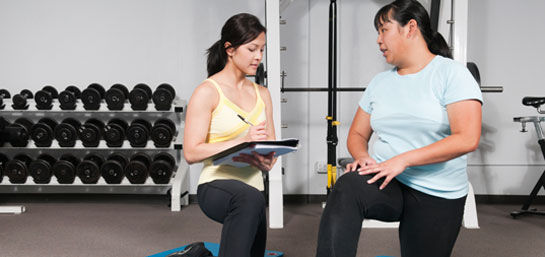
By CHRIS FREYTAG
America’s obesity epidemic—what some jokingly refer to as our collective battle of the bulge—is no laughing matter, particularly since many of the diseases that plague Americans are directly related to growing waistlines and unhealthy habits that have become the norm. With the national obesity rate at 26.5 percent, and the percentage of overweight Americans topping 60 and escalating, is there really anything one person—or one fitness professional—can do to make a difference?
The answer, of course, is yes, but there isn’t a single, sweeping gesture that will make the difference for society, a community or even one individual. As anyone who has ever lost weight or improved his or her lifestyle can tell you, it isn’t one single thing that makes the difference—it’s the small, individual steps and changes that add up over time that ultimately have the largest impact. On a daily basis, fitness professionals have the opportunity to positively impact those within our sphere of influence, which includes just about everyone with whom we come into contact. In fact, the simple act of modeling healthy behaviors, something most of us do without even thinking about it, can have a profound impact on those seeking to improve their health and well-being.
But there is so much more we can do to help our clients lose and maintain a healthy weight. In addition to setting a healthy example, we also need to arm ourselves with the knowledge and skills to help people make healthy changes that will last a lifetime. Rather than offering our clients and participants promises and quick fixes, we can give them something infinitely more valuable—the information, education and motivation they need to live healthier lives.
Reality Check
One-third of the people in the United States are considered obese, according to the Centers for Disease Control and Prevention. Obesity is responsible for more than 160,000 excess deaths a year, reports the Journal of the American Medical Association. Educating people on the risks they are taking with their health and their lives is of critical importance because it could prompt change. Denial can become a comfortable place to exist, and some people only decide to change when faced with the stark reality of possible illness and a shortened lifespan.
Small Steps, Big Rewards
The basic principle of weight loss is deceptively simple—burn more calories than you consume—and yet putting this principle into action is often anything but easy, particularly for those who are obese. With their weight spiraling out of control, many obese adults feel hopeless, so they don’t even begin the battle. Yet studies show even modest weight loss can begin to alleviate the health problems associated with obesity. Instead of trying to encourage your clients to make a radical transformation from obese to buff, use the following tips to help your clients make small but significant lifestyle changes that can make a big difference over time.
Food and Portion Control
When it comes to food, it’s all about the two “Q’s”—quality and quantity—and looking for opportunities to encourage clients to choose whole foods vs. processed or prepared foods. This is the best advice you can offer and you don’t risk veering outside the bounds of your scope of practice as a fitness professional. You can also teach clients (whether or not they struggle with weight) how to decipher food labels, how to distinguish between good and bad fats, and the basics of how the body utilizes the carbohydrates, fats and protein we consume.
And, of course, we need to continue to educate people about portion control, because for many it’s not what they eat, it’s how much. Food preparation is also key. We can provide education on food preparation and the pitfalls of fried foods, sodium-laden dips and sauces, high-calorie snacks and beverages loaded with sugar.
Food journals are a great and user-friendly way to help clients make small changes by showing them exactly what they eat and even the reasons why. In fact, tracking food and calorie intake has never been easier now that there are so many smartphone apps, tools and online programs available (many for free). These tools can also be a great source of motivation.
Accountability
While we can’t be there for every person all the time (after all, we often spend just an hour or two per week with each client or class participant), we can encourage people to find accountability partners—someone who will offer support and guidance on their journey to lose weight. Accountability can come from many different sources—family members, coworkers, friends and even virtual sources. For example, the Fit Bit® and GoWear® fit are two accountability tools that track everything from sleep patterns to calories burned. Worn on the arm or waistband, these devices can help your clients track lifestyle patterns by monitoring things like sleep duration, steps, calories burned and time spent doing physical activity. This continuous feedback enhances users’ awareness of how the choices they make each day affect their health and well-being. [Don’t miss ACE’s expert reviews of the Fit Bit and GoWear fit on ACE’s Product Review Web site.]

Making Every Step Count
Getting clients moving more is essential—and not just when they are participating in our classes or training sessions. In addition to their regular workouts, simply encourage your clients to move a little bit more than they did the day before. An hour-long workout is great, but if the next eight hours are spent sitting in a chair, it will be hard to see the weight-loss or body-shape changes they are seeking. Overall physical activity throughout the day is as important as a designated workout session. A simple pedometer or a more advanced monitor (like those previously mentioned) are both great ways to track steps and monitor total daily activity.
Moving more can create lasting change—even with more active housework, gardening or actively playing with kids. The old tricks of taking the stairs or parking farther away from work or the store are strategies that can actually enhance weight-loss efforts. Again, it’s all about small changes that, like compound interest, pay big dividends over time.
Help your clients to set realistic, achievable goals that can be accomplished in a short period of time—so they can stair step their way to lasting change and celebrate small wins along the way.
The Importance of Sleep
People underestimate the significance of sleep and how it factors into their health. Sleep strongly influences metabolism, appetite, and weight gain and loss. The National Sleep Foundation indicates that inadequate sleep is associated with diabetes in older adults and an increase in heart disease. Sleep is vital for sustaining peak mental performance, stabilizing mood, boosting immunity, coping with stress and regulating metabolism. While we sleep, biological processes are restoring us, so we can be more productive and alert the next day.
Getting enough sleep—eight hours a night—can even help your clients keep weight off. When people don't get enough sleep, leptin levels go down, and then they don’t feel as satisfied after they eat. Lack of sleep also causes ghrelin levels to rise, which means appetite is stimulated, making people hungrier. Most experts recommend at least seven hours of sleep at night, so encourage your clients to go to bed and wake up at about the same time every day.
Now Is the Time
“Be the change you want to see in the world.” These words, spoken by Gandhi so many decades ago, remain relevant for the challenges we face today, including obesity. It’s time for fitness professionals to step up and help turn the tide against this obesity epidemic, one person at a time. Focus on your corner of the world and let’s see what we can accomplish together.
________________________________________________________________________
 Chris Freytag is a health and fitness expert, blogger, author and motivational speaker. She has been teaching fitness classes and personal training for more than 20 years. She is a columnist for Prevention Magazine, a fitness contributor for the NBC affiliate in Minneapolis and a member of the ACE Board of Directors. Chris has authored five books; has created dozens of fitness DVD’s and workouts for Exercise TV; and sells her signature line of healthy kitchen and fitness products on QVC. Check out her latest cookbook, CHOOSE THIS!, available at www.qvc.com. Connect with Chris daily for motivation at wwwfacebook.com/chrisfreytagpage.
Chris Freytag is a health and fitness expert, blogger, author and motivational speaker. She has been teaching fitness classes and personal training for more than 20 years. She is a columnist for Prevention Magazine, a fitness contributor for the NBC affiliate in Minneapolis and a member of the ACE Board of Directors. Chris has authored five books; has created dozens of fitness DVD’s and workouts for Exercise TV; and sells her signature line of healthy kitchen and fitness products on QVC. Check out her latest cookbook, CHOOSE THIS!, available at www.qvc.com. Connect with Chris daily for motivation at wwwfacebook.com/chrisfreytagpage.